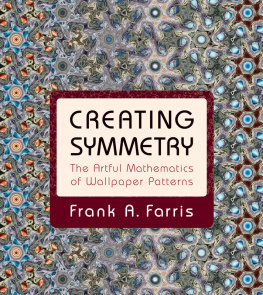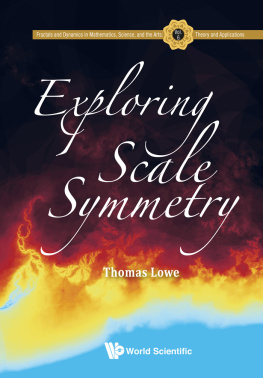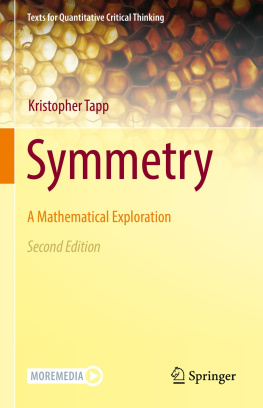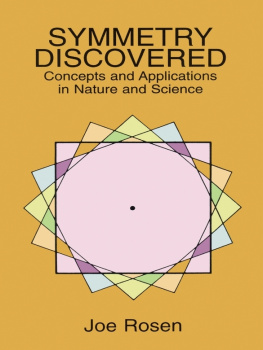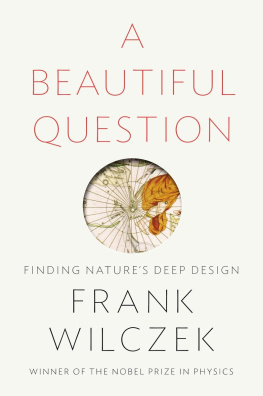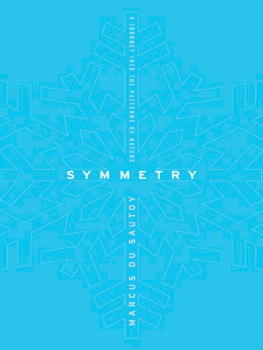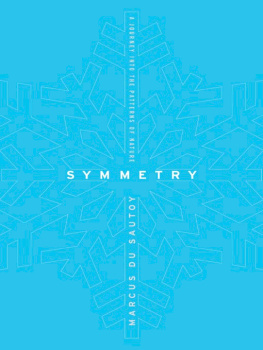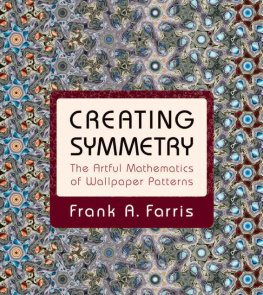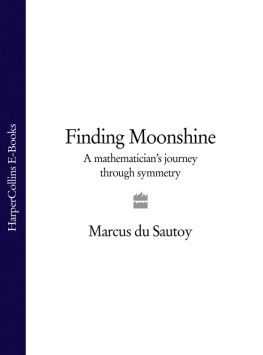
CREATING SYMMETRY
CREATING SYMMETRY
The Artful Mathematics of Wallpaper Patterns
Frank A. Farris
Princeton University Press Princeton and Oxford
Copyright 2015 by Princeton University Press
Published by Princeton University Press, 41 William Street,
Princeton, New Jersey 08540
In the United Kingdom: Princeton University Press, 6 Oxford Street,
Woodstock, Oxfordshire OX20 1TW
press.princeton.edu
Kaiser Peach, a morphing frieze with inset, by Frank A. Farris, 2012.
All Rights Reserved
Library of Congress Cataloging-in-Publication Data
Farris, Frank A.
Creating symmetry : the artful mathematics of wallpaper patterns / Frank A. Farris.
pages cm
Includes bibliographical references and index.
ISBN 978-0-691-16173-0 (hardcover : alk. paper)ISBN 0-691-16173-9 (hardcover : alk. paper) 1. Symmetry (Mathematics) 2. Symmetry (Art) I. Title.
QA174.7.S96F37 2015
516.1dc23
2014040468
British Library Cataloging-in-Publication Data is available
This book has been composed in Minion, Bauhaus & Avenir
Printed on acid-free paper.
Typeset by S R Nova Pvt Ltd, Bangalore, India
Printed in Canada
1 3 5 7 9 10 8 6 4 2
Contents
Preface

Figure 1.Kaiser Peach, an offering of mathematical art.
The word symmetry often evokes simple bilateral symmetry, as in an idealized human face or the two wings of a butterfly. For mathematicians, the concept is richer and more fun, ranging from the patterns of wallpaper to the symmetries of a molecule or crystal.
Indeed, the concept of symmetry offers an attractive gateway to mathematicsor perhaps to a part of mathematics you havent encountered yet. The natural delight we take in images like inspires us to ask what sparks that feeling of recognition, to want to know more about how they are made. This book is my attempt to address those yearnings. I hope that the patterns I showas beautiful as I know how to make themwill help you connect more deeply to mathematics, at whatever level you are working.
What does creating symmetry mean? A child can create symmetry by repeatedly stamping out a pattern with a carved potato, but mathematics gives us far more powerful and satisfying tools than a potato stamp.
Dissatisfied by reading so many treatments of symmetry that express patterns as things broken up into piecesthose potato stampsI have developed methods to construct mathematical objects whose very nature is symmetry. I use the vocabulary of functions, in particular wave functions, which you can picture as the long, regular waves in the deepwater ocean. When these are combined in just the right ways, we can construct functions with any imagined type of symmetry, functions that, as their essence, dance along in step as if to a perfectly symmetric tune. This is creating symmetry.
This is at once a story of freedom and constraint: We can create images of dazzling variety, using photographs to incorporate colors and textures from the world around us. On the other hand, there are mathematical restrictions on pattern types, restrictions imposed by any sort of requirement that a pattern repeat itself in some given way. It may surprise you, but every regular pattern created by any human at any time in historyas long as it really is regularcan be classified according to a rather rigid classification scheme. For instance, if you want to make a wallpaper pattern with 6-fold rotational symmetry, as in the left-hand strip of , it will always turn out to be one of the two 6-fold types I will show you how to make. No one can make a type that is not on the list.
The classification of patterns by their symmetry is ideal for a first encounter with the mathematical concept of group, or for deepening your understanding if youve already met this technical mathematical structure. In designing any pattern, there is a significant constraint: If you plan to have some symmetries in a pattern, you must necessarily have specific others, which come along with the planned ones as baggage. For me, this limitation exemplifies a sort of platonic suchness: Its easy for me to view the short list of pattern types as a mathematical object that exists independent of human inquiry, something that is there, waiting to be discovered. As you learn more about the group concept, I hope you will see what I mean.
Finally, by creating symmetry I mean the artistic process of making choices among the vast infinity of these mathematical patternsfree to wave and curve but constrained by the limitations of pattern type. The choices include selecting a photograph to be married with a mathematical process to create something new. I refer to the human, even emotional, encounter with those special examples that demand to be shared with others, to be put on the wall or printed on fabric and offered, not just as mathematics but as art.
As we learn to create symmetry, I offer my personal take on artistic choice and show you how to experiment for yourself. Perhaps you too will create an image like .
Ways to Read This Book
On one hand, the mathematical content of this book is rather sophisticated; on the other, everything can be approached from an elementary point of view. In preparing each chapter, I have done my best to provide access for those who may be learning concepts for the first time and to offer a helpful first experience with things like groups, projection operators, eigenfunction expansions, and so on. These rather elevated mathematical concepts are not so scary when illustrated in specific examples, especially when we can see what they look like in what I think are attractive illustrations.

Figure 2. Created symmetry, from a photograph () of peppers and greens on a cutting board.
As I wrote, I kept in mind three types of readers: the working mathematician, the advanced undergraduate, and the brave mathematical adventurer. I do believe that readers without extensive mathematical background beyond calculuswho are hooked by the artwork and willing to learncan have a fine experience working through my story of symmetry.
F OR THE L ESS E XPERIENCED R EADER. I am eager to share my favorite mathematical concepts with you. Getting to know them requires some work, but help is abundantly available. There are many places where I invite you to skip over some technicalities. Save something for a second reading!
The mathematical prerequisite is some knowledge of calculuswe will compute derivatives of functions and, to a lesser extent, talk about some integrals. No knowledge of abstract algebra or analysis is required; everything we need will be built slowly as we go. I write for readers willing to apply their knowledge of number systems, calculus, and elementary geometry, willing to work vigorously toward some rather sophisticated ideas, with refreshment provided by the visual beauty of symmetry. If this is you, exercises marked with one or two asterisks might best be skipped on a first reading. On the other hand, be sure to do the unflagged exercises to test your understanding.
F OR THE A DVANCED U NDERGRADUATE. Some of the first chapters of this book may be easy for you. Consider them a review of parametric equations, complex numbers, and basic group theory, all applied in situations you probably have not studied. As the book progresses, you will meet many topics in the standard undergraduate curriculum. If you have seen them before, it was surely not in this context; if you havent, youll get an excellent preview for future study.
Next page
